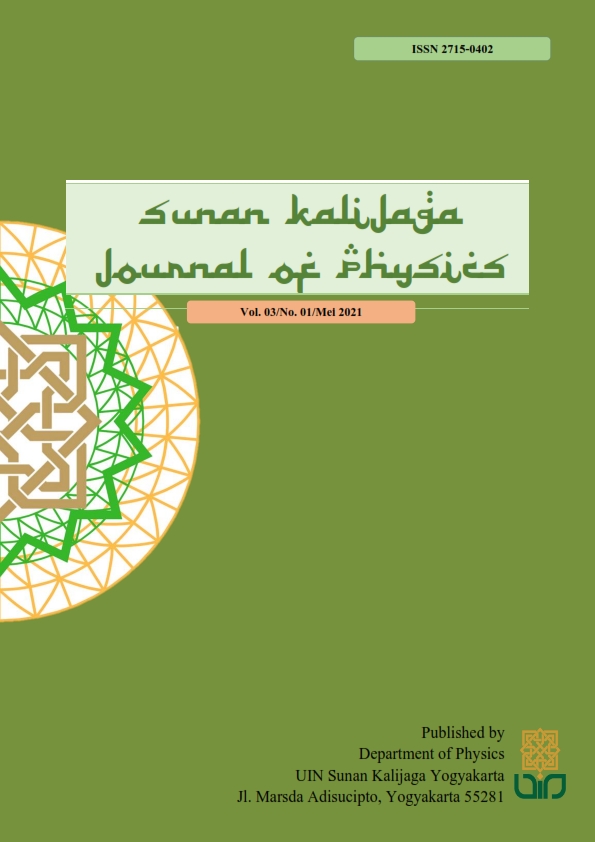Rancang Bangun Prototype Single Electrode EEG Berbasis Arduino Uno
DOI:
https://doi.org/10.14421/physics.v3i1.2301Keywords:
Arduino Uno, brain signal, Electroencephalography (EEG), frontal lobeAbstract
Research on electroencephalography (EEG) design as a detector of brain signal activity in the frontal lobe based on Arduino Uno has been completed. EEG is a tool used to record electrical activity in the human brain. This research aims to make a non-clinical EEG device that is portable and low-cost. The research procedure is divided into three stages. The first stage is to design an EEG system using the Eagle application. The second stage is to create an EEG system which consists of the primary circuit of the EEG system, power supply, Arduino Uno, and two electrodes. The third stage is testing the EEG system, which includes testing the instrumentation amplifier, low pass filter, power supply, Arduino ADC consistency, and initial testing of EEG performance to record brain signals. The instrumentation gain is 51 times based on the test with an average accuracy rate of 99.09%. Meanwhile, the cut-off frequency obtained is 70 Hz. The comparison between brain signal measurements using a single electrode prototype EEG and standard EEG Emotiv Epoc with electrode placement at points Fp1 and A2 (ground) show almost the same pattern. So it can be said that the single EEG system created has been successfully used to record brain activity in the frontal lobe area.
References
Nunez PL, Srinivasan R. Electric fields of the brain: the neurophysics of EEG. Oxford: Oxford University Press, 2006.
Parlindungan, R. “Analisis waktu-frekuensi (TFA) Gelombang EEG Naracoba pada Stimulasi Akupuntur GI”.(Tesis): Program Studi Magister Instrumentasi dan Kontrol, ITB, Bandung, 2018.
Acharya, U.R., Bhat S., Faust O., Adeli H., Chya E.C.P., Lim W.J.E, Koh J.E.W, “Nonlinear Dynamics Measures for Automated EEG Based Sleep Stage Detection”, European Neurology, 2015: 74, pp. 268-287, https://doi.org/10.1159/000441975
Bauer, R. M., & Dunn, C. B. Research methods in neuropsychology. Dalam I. B. Weiner, J. A. Schinka, & W. F. Velicer, Handbook of psychology: Research methods in psychology (Vol. II, Edisi kedua). John Wiley & Sons Inc., 2015, 274-315.
Boshra, R., Ruiter, K. I., DeMatteo, C., Reilly, J. P., & Connolly, J. F. “Neurophysiological correlates of concussion: Deep learning for clinical assessment”. Scientific Reports, 9(1), 17341, 2019. https://doi.org/10.1038/s41598-019-53751-9
Grau, C., Ginhoux, R., Riera, A., Nguyen, T. L., Chauvat, H., Berg, M., … Ruffini, G. “Conscious brain-tobrain communication in humans using non-invasive technologies”. PLoS One, 9(8), e105225, 2014. https://doi.org/10.1371/journal.pone.0105225.
Bandara, D. S. V., Arata, J., & Kiguchi, K. “Towards control of a transhumeral prosthesis with EEG signals”. Bioengineering, 5(2), 26, 2018. https://doi.org/10.3390/bioengineering5020026
Ratti, E., Waninger, S., Berka, C., Ruffini, G., & Verma, A. “Comparison of medical and consumer wireless EEG systems for use in clinical trials”. Frontiers in Human Neuroscience, 11, 398, 2017. https://doi.org/10.3389/fnhum.2017.00398.
Nicholas A. Badcock, Kathryn A. Preece, Bianca de Wit, Katharine Glenn, Nora Fieder, Johnson Thie and Genevieve McArthur, “Validation of the Emotiv EPOC EEG system for research quality auditory eventrelated potentials in children”, PeerJ 3:e907, April, 2015. DOI 10.7717/peerj.907
Pratama S.H., Rahmadhani A., Bramana A., Prihatin O., Handayani N., Haryanto F., Suprjadi and Khotimah S.N., “Signal Comparison of Developed EEG Device and Emotiv Insight Based on Brainwave Characteristics Analysis”, Journal of Physics: Conference Series 1505 (2020) 012071 IOP Publishing. doi:10.1088/1742-6596/1505/1/012071.
Downloads
Published
How to Cite
Issue
Section
License
Copyright (c) 2021 Yulia Savitri Handayani Savitri Handayani, Nita Handayani, Ade Kurniawan

This work is licensed under a Creative Commons Attribution-ShareAlike 4.0 International License.







